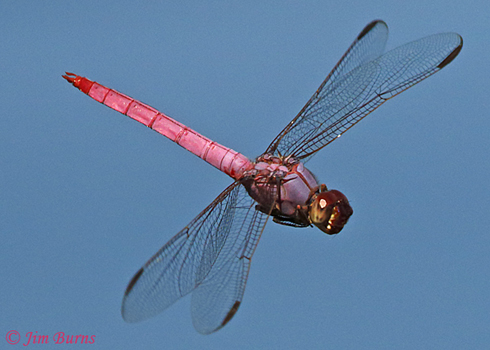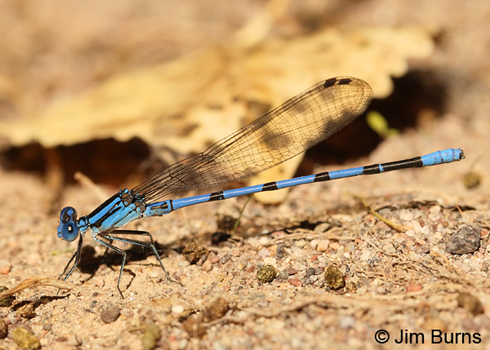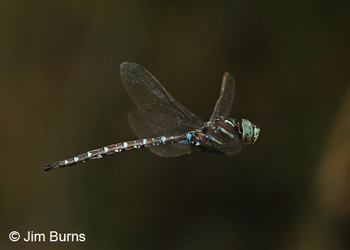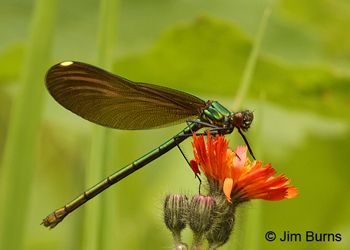I had been a lifelong adult birder, perhaps the more passionate because I had not been exposed to the wonder of birds as a child. For forty years I had relished the intellectual stimulation of studying birds, the physical activity of searching for them, and the adrenaline surge of actually finding new ones. Like Brian, I had covered most of North America, and I had even made a few forays out of the country, but I too missed the thrill of a potential lifer around any turn in the path. And, tired of the often competitive aspects of listing, I had quit chasing rarities and was concentrating on bird photography.
One August morning I was set up, telephoto lens on tripod, watching a Common Black Hawk nest, waiting for the parents to return with a frog or crayfish for two half grown nestlings. Out of the corner of my eye I noticed movement ahead on the path along the creek. I was a little bored, so I swung the lens downward, refocused closer, right at the minimum distance of the lens, and took a couple perfunctory frames of a large, wine-colored dragonfly that had landed on a weed stalk.
Always excited by the occasional glimpse of wild mammals, only casually attuned yet to the beauty of butterflies, I hadn’t so much as glanced at a dragonfly since high school Biology class. Fifty years and counting at that time. You’ve probably noticed dragonflies are smaller and faster than birds, mammals, and butterflies. That’s my only excuse. Magnifying the image on the back of the camera, I saw a stunning and intriguing creature for which I wanted a label . . . and more information and knowledge.
More on that later, but although I’m now back into photographing birds whenever I encounter unique plumages or unusual behaviors, and in winter of course (when odes aren’t flying), I spent the two ensuing summers hardly looking at birds, pretty much doing just dragonflies with binoculars and camera.
Worldwide there are upwards to 6000 species of odonates, and 450, give or take, can be found in North America, climate change pushing the possibilities higher as Latin American dragonflies find their way to Florida, Texas, and Arizona. There are both similarities and differences between birding and odeing, but one of my first impressions has held true over the intervening years—dragonflies are harder than birds to find (smaller and faster, remember) but easier to photograph (they’ll sit longer, they can’t hear, so noise will not spook them, and they often return to the same perch.
If 700 is the Holy Grail for birders with lists, 400 would be the comp for oders. For many of the challenges dragonflies present, there seem to be ameliorating factors, but birders getting into dragons will have one major hurdle to clear. Most find it difficult to bird and ode at the same time or on the same field trip. It seems to be a question of focus, both mental and visual. Looking for odonates requires much slower, more deliberate search methods lest tiny movements against more mottled backgrounds be missed, and ode seekers must learn to redirect their search from eye level, middle distance, and up, to eye level, in close, and down. And yes, close focus binoculars are highly recommended for positive identification purposes.
Odonate real estate, just like birding, is habitat, habitat, habitat. Dragons and damsels need water and food. Their larvae undergo several molts (average is perhaps a dozen) which, depending on latitude, may take as little as a month or up to several years, as they feed under the water, then emerge from the water, mate, and deposit their eggs back into the water. Food is critical in the adult stage, their flight season when you actually see them, because they are then near the end of their life cycle and have only a few days, perhaps up to a few months to get the job of mating done. They are voracious predators, feeding constantly and on anything smaller than themselves, particularly flies and mosquitos, and they will take butterflies and other odonates, including those of their own species!
Birds are all around us. Dragonflies, not so much. Birds are migratory, different suites of species in a given place at different times of the year. Odonates compress and fragment those calendar paradigms. There are few, if any, in winter, their flights seasons are often very short, some are highly localized, present at one boat ramp but absent at the next one half a mile down the river...Only a handful are considered migratory, a term which, in their case, applies to generations rather than individuals. So, yes, they’re harder to find than birds.
There are some positives, though. You don’t have to get up early because sunshine to warm up their flight muscles is a higher priority than even water and food and, although one of the joys cited by many dragonflyers is splashing down a creek in old tennis shoes, you don’t have to get wet. Many species feed mostly over meadows, along forest trails, and on streamside vegetation. And, there’s no reason to endure cold weather to look for them. Odes don’t do winter or cold weather.
For birders who like ID challenges, there is a family of damsels called dancers comprised of 33 species, most of the males blue, the females blueish or brown, all about 1.2 inches long. Did I mention close focus binoculars? For birders who like to travel, there is an eye catching family of dragons called clubtails comprised of 100 species, from the Two-striped Forceptail in Florida to the Grappletail in the Pacific Northwest, most of them two to three inches in length with spectacular appendages at the ends of their abdomen. One clubtail species has been found only in five counties in Tennessee. Did I mention highly localized?
Which brings us to that “dark side” reference. Up close and personal, through a macro camera lens or actually in hand, the “beauty” of odonates can best be modified with the adjective “gothic.” Their most prominent feature is the huge, compound eyes, which in some species wrap around the entire head and provide 360 degree vision, the best in the insect world. At the other end, at the tip of the male abdomen, is a set of appendages called claspers with which he grabs a female in flight to mate, attaching the claspers to the back of her head to secure her. These appendages come in various forms, some resembling medieval torture devices (remember the species called forceptails).

Shadow Darner male in flight |
River Jewelwing female on Hawkweed |

